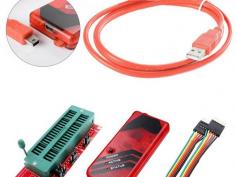
PICKIT3 USB Debugger
Introducing the PICKIT3 USB Debugger Programmer Emulator Controller Development board. Its USB connection provides a reliable alternative to the ICD2. With an offline burning feature, it allows for convenient programming and batch burning of products. The power supply input can be easily managed through MPLAB IDE.
Introducing PICKIT3.5, now compatible with Win7 operating system. With a complete patch design and reflow soldering processing, the quality of our product is more reliable. We also provide developing data for PICs and a manual for C language development tools. You can explore numerous basic experiment program codes for PICs, along with details on how to use ICD2 and PICKIT3 effectively.
At a highly cost-effective price, the MPLAB PICkit 3 enables debugging and programming of both PIC® and dsPIC® Flash microcontrollers. Its user-friendly graphical interface is integrated into the MPLAB IDE. This tool connects to a design engineer’s PC through a full-speed USB interface and can be linked to the target via a Microchip debug (RJ-11) connector, which is compatible with MPLAB ICD 2, MPLAB ICD 3, and MPLAB REAL ICE.
The key elements of PICKIT3 USB Debugger:
Full-speed USB support with compatibility using standard drivers for Windows operating systems.
Executing in real-time
Processors operate at their highest possible speeds.
The monitor includes protection against both over-voltage and short circuits.
The voltage should be kept below 5V, within the range of 1.8 to 5V.
Manipulate the microcontroller’s program and data memory.
The diagnostic LEDs for power, activity, and status.
Manipulate program and data memory of the microcontroller
Perform a memory wipe, including all types of memory (EEPROM, ID, configuration, and program), with verification.
The breakpoint causes a freeze in the peripheral.
Input a maximum of 512K bytes of data into the program’s flash storage.

